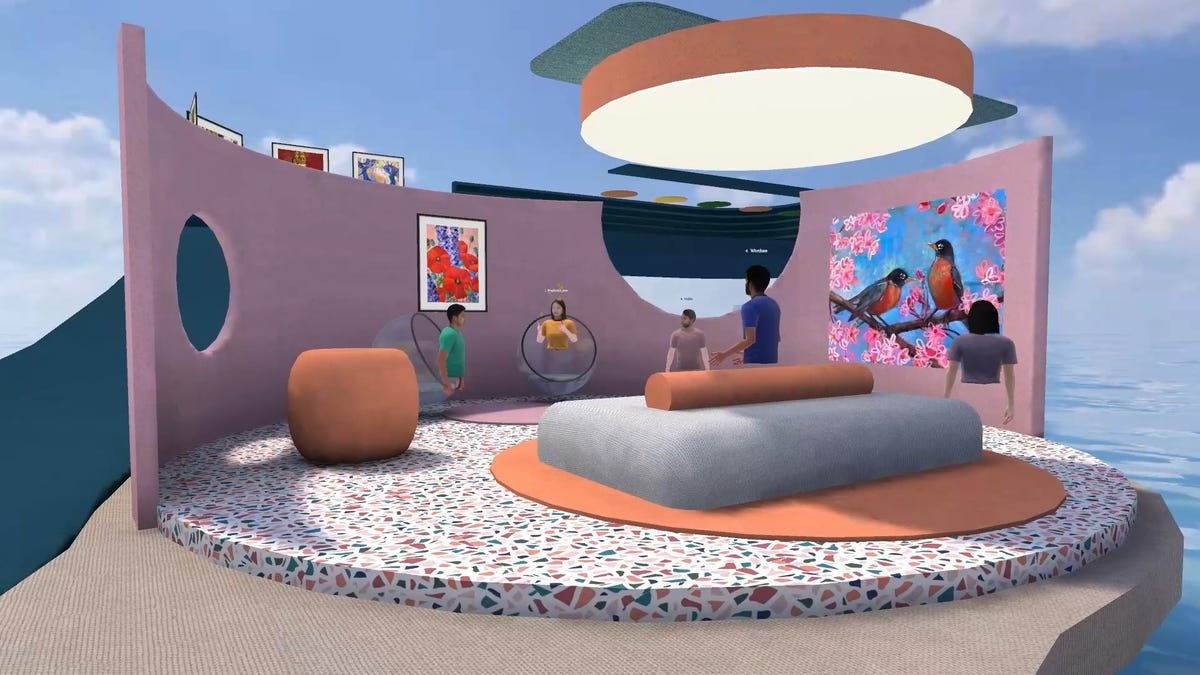Spatial shifts its metaverse focus to the web, and selling NFT real estate
One of VR's key social apps is moving away from VR headsets, and towards the web and commerce.

Spatial's 3D meeting spaces were mainly meant for VR and AR. Now they're becoming web-based galleries to sell NFTs.
I was invited to connect with the creators of Spatial, a social metaverse meeting space app I've used many times. But this time, we weren't using VR headsets. We were just connecting on my laptop, looking at NFT virtual homes. Is this where metaverse strategies are heading next year?
Spatial was one of the early explorers of workplace meeting areas in AR and VR. The company's latest shift, however, is towards the web. It's found a new financial path as a gallery space and host for NFT creators and their works, and according to Spatial's team, that makes more sense in web browsers on computers, tablets and phones. But Spatial is also moving into more immersive NFTs, selling and renting entire NFT environments that could be places for people to meet. It says these files could eventually work across metaverse apps.
Whether or not Spatial's environmental NFT files will work across apps depends on whether other apps support the GLB file format they're created in. GLB is a popular 3D file format for VR and AR, but it remains unclear how metaverses such as Meta's Horizon Worlds, for example, will work with files like these.
I took a look at Bozo Island, a space with avatars meant to be set in the year 3333, made by creator Renaud. "We're minting 64 editions. Anyone can come in, and if they want to buy this unique space, they can mint it, and they will be one of 64 people who uniquely have access to this space. They could use it for exhibitions, or events, whatever they want to," Spatial's Head of Business, Jacob Loewenstein, said as we met inside Bozo Island in Spatial. The Spatial app scans an account's wallet for a crypto token of the transaction, which then allows access to the space. "We're pretty excited to getting into the business of selling people their own unique home and unique space in the metaverse," says Loewenstein.
I visited one of Spatial's first virtual gallery spaces for more "traditional" NFTs earlier this year, where I looked at 2D and 3D artworks with a VR headset on, while chatting with creators who appeared as avatars. On a web browser, the experience is pretty much the same, minus the more expansive sense of headset immersion. I can see my avatar moving around on my laptop screen, and everyone else's. I move around with keyboard buttons and the trackpad. One big difference, using a laptop or a phone: I can show my face in a video screen bubble over my avatar. It's the type of face-to-face interaction that VR headsets still lack.
The Hermitage's NFT art gallery in Spatial.
Spatial's already worked on art gallery NFT spaces in partnership with The Hermitage and the NBA, and a number of other creators (I visited a house-size work earlier this year, a NFT space called Mars House created by Krista Kim.)
This doesn't mean Spatial is saying goodbye to VR and AR headsets: the app's still around, and I find it useful to hop into as a more close-up way of exploring 3D content or art. But using a regular computer, and having its keyboard and interface and multitasking capabilities, has clear advantages, especially for things like commerce. Spatial's co-founder and CEO, Anand Agarawalla, also points to the far larger number of people that browsers can command over headsets. "We were a little skeptical, for sure," Agarawalla says of the NFT-related growth of Spatial, but he feels the changes reflect what NFT-interested Spatial users want. "Recently the growth has been amazing. I think it tripled in the last month alone, and it's going straight up."
As metaverse hype continues into 2022, it's worth noting that one of VR and AR's most prominent companies is shifting away from headsets. The metaverse has never just been about AR and VR goggles, and the move to widen access seems like a trend that will continue next year no matter what new hardware emerges.

